Simulating Potential Impacts of Fuel Treatments on Fire Behavior and Evacuation Time of the 2018 Camp Fire in Northern California
Abstract
:1. Introduction
2. Materials and Methods
2.1. Case Study
2.2. Fire Growth Model
2.3. Weather and Fire Weather Index System Data
2.4. Landscape Data
2.5. WUI Fuel Break Design
2.6. Model Evaluation and Experiments
3. Results
3.1. Model Calibration
3.2. Impact of WUI Fuel Breaks on Downstream Fire Behavior
3.3. Impact of the Grass Fuel Conditions over the WUI Fuel Break on Downstream Fire Propagation
3.4. Role of Wind Speeds in the Effectiveness of WUI Fuel Breaks
4. Discussion
5. Conclusions
Supplementary Materials
Author Contributions
Funding
Data Availability Statement
Acknowledgments
Conflicts of Interest
References
- Keeley, J.E.; Syphard, A.D. Twenty-first century California, USA, wildfires: Fuel-dominated vs. wind-dominated fires. Fire Ecol. 2019, 15, 24. [Google Scholar] [CrossRef] [Green Version]
- Byram, G.M. Forest fue behavior. In Forest Fire: Control and Use; Davis, K.P., Ed.; McGraw-Hill: NewYork, NY, USA, 1959; pp. 90–123. [Google Scholar]
- Kiefer, M.T.; Parker, M.D.; Charney, J.J. Regimes of Dry Convection above Wildfires: Idealized Numerical Simulations and Dimensional Analysis. J. Atmos. Sci. 2009, 66, 806–836. [Google Scholar] [CrossRef] [Green Version]
- Morvan, D. Wind Effects, Unsteady Behaviors, and Regimes of Propagation of Surface Fires in Open Field. Combust. Sci. Technol. 2014, 186, 869–888. [Google Scholar] [CrossRef]
- Rothermel, R.C. Predicting Behavior and Size of Crown Fires in the Northern Rocky Mountains; Research Paper INT438; United States Department of Agriculture, Forest Service, Intermountain Research Station: Ogden, UT, USA, 1991; p. 46. [Google Scholar] [CrossRef]
- Keeley, J.E.; Syphard, A. Historical patterns of wildfire ignition sources in California ecosystems. Int. J. Wildland Fire 2018, 27, 781. [Google Scholar] [CrossRef] [Green Version]
- Werth, P.A.; Potter, B.E.; Alexander, M.E.; Clements, C.B.; Cruz, M.G.; Finney, M.A.; Forthofer, J.M.; Goodrick, S.L.; Hoffman, C.; Jolly, W.M.; et al. Synthesis of Knowledge of Extreme Fire Behavior: Volume 2 for Fire Behavior Specialists, Researchers, and Meteorologists; General Technical Reports PNW-GTR-891; Department of Agriculture, Forest Service, Pacific Northwest Research Station: Portland, OR, USA, 2016; p. 258. [Google Scholar]
- Countryman, C.M. Can Southern California Wildland Conflagrations be Stopped? In General Technical Report, PSW-7; USDA Forest Service, Pacific Southwest Forest and Range Experiment Station: Berkeley, CA, USA, 1974; pp. 1–11. [Google Scholar]
- Abatzoglou, J.T.; Balch, J.K.; Bradley, B.A.; Kolden, C. Human-related ignitions concurrent with high winds promote large wildfires across the USA. Int. J. Wildland Fire 2018, 27, 377. [Google Scholar] [CrossRef]
- Balch, J.K.; Bradley, B.A.; Abatzoglou, J.T.; Nagy, R.C.; Fusco, E.J.; Mahood, A.L. Human-started wildfires expand the fire niche across the United States. Proc. Natl. Acad. Sci. USA 2017, 114, 2946–2951. [Google Scholar] [CrossRef] [Green Version]
- Radeloff, V.C.; Helmers, D.P.; Kramer, H.A.; Mockrin, M.H.; Alexandre, P.M.; Bar-Massada, A.; Butsic, V.; Hawbaker, T.J.; Martinuzzi, S.; Syphard, A.D.; et al. Rapid growth of the US wildland-urban interface raises wildfire risk. Proc. Natl. Acad. Sci. USA 2018, 115, 3314–3319. [Google Scholar] [CrossRef] [Green Version]
- Syphard, A.; Keeley, J. Factors Associated with Structure Loss in the 2013–2018 California Wildfires. Fire 2019, 2, 49. [Google Scholar] [CrossRef] [Green Version]
- Safford, H.D.; Schmidt, D.A.; Carlson, C.H. Effects of fuel treatments on fire severity in an area of wildland–urban interface, Angora Fire, Lake Tahoe Basin, California. For. Ecol. Manag. 2009, 258, 773–787. [Google Scholar] [CrossRef]
- Agee, J.K.; Bahro, B.; Finney, M.A.; Omi, P.N.; Sapsis, D.B.; Skinner, C.N.; van Wagtendonk, J.W.; Weatherspoon, C.P. The use of shaded fuelbreaks in landscape fire management. For. Ecol. Manag. 2000, 127, 55–66. [Google Scholar] [CrossRef]
- Oliveira, T.M.; Barros, A.M.G.; Ager, A.A.; Fernandes, P.M. Assessing the effect of a fuel break network to reduce burnt area and wildfire risk transmission. Int. J. Wildland Fire 2016, 25, 619–632. [Google Scholar] [CrossRef]
- Syphard, A.D.; Keeley, J.E.; Brennan, T.J. Factors affecting fuel break effectiveness in the control of large fires on the Los Padres National Forest, California. Int. J. Wildland Fire 2011, 20, 764–775. [Google Scholar] [CrossRef]
- Gibbons, P.; Van Bommel, L.; Gill, A.M.; Cary, G.J.; Driscoll, D.A.; Bradstock, R.A.; Knight, E.; Moritz, M.A.; Stephens, S.L.; Lindenmayer, D.B. Land Management Practices Associated with House Loss in Wildfires. PLoS ONE 2012, 7, e29212. [Google Scholar] [CrossRef] [PubMed]
- Syphard, A.D.; Brennan, T.J.; Keeley, J.E. The role of defensible space for residential structure protection during wildfires. Int. J. Wildland Fire 2014, 23, 1165–1175. [Google Scholar] [CrossRef]
- Cohen, J.D.; Stratton, R.D. Home Destruction Examination: Grass Valley Fire, Lake Arrowhead, California; Tech. Paper R5-TP-026b; U.S. Department of Agriculture, Forest Service, Pacific Southwest Region (Region 5): Vallejo, CA, USA, 2008; p. 26. Available online: https://www.fs.usda.gov/treesearch/pubs/31544 (accessed on 24 November 2021).
- Gibbons, P.; Gill, A.M.; Shore, N.; Moritz, M.A.; Dovers, S.; Cary, G.J. Options for reducing house-losses during wildfires without clearing trees and shrubs. Landsc. Urban Plan. 2018, 174, 10–17. [Google Scholar] [CrossRef]
- Varner, J.; Keyes, C. Fuels treatments and fire models: Errors and corrections. Fire Manag. Today 2009, 69, 47–50. [Google Scholar]
- Ager, A.A.; Finney, M.A.; Kerns, B.K.; Maffei, H. Modeling wildfire risk to northern spotted owl (Strix occidentalis caurina) habitat in Central Oregon, USA. For. Ecol. Manag. 2007, 246, 45–56. [Google Scholar] [CrossRef]
- Carmel, Y.; Paz, S.; Jahashan, F.; Shoshany, M. Assessing fire risk using Monte Carlo simulations of fire spread. For. Ecol. Manag. 2009, 257, 370–377. [Google Scholar] [CrossRef]
- Cruz, M.G.; Alexander, M.E. Modelling the rate of fire spread and uncertainty associated with the onset and propagation of crown fires in conifer forest stands. Int. J. Wildland Fire 2017, 26, 413–426. [Google Scholar] [CrossRef]
- Finney, M.A.; Grenfell, I.C.; McHugh, C.W.; Seli, R.C.; Trethewey, D.; Stratton, R.D.; Brittain, S. A Method for Ensemble Wildland Fire Simulation. Environ. Model. Assess. 2011, 16, 153–167. [Google Scholar] [CrossRef]
- Ramirez, J.; Monedero, S.; Silva, C.; Cardil, A. Stochastic decision trigger modelling to assess the probability of wildland fire impact. Sci. Total Environ. 2019, 694, 133505. [Google Scholar] [CrossRef] [PubMed]
- Maranghides, A.; Link, E.; Mell, W.; Hawks, S.; Wilson, M.; Brewer, W.; Brown, C.; Vihnaneck, B.; Walton, W.D. A Case Study of the Camp Fire–Fire Progression Timeline; Technical Note (NIST TN), National Institute of Standards and Technology: Gaithersburg, MD, USA, 2021. [Google Scholar] [CrossRef]
- Brewer, M.J.; Clements, C.B. The 2018 Camp Fire: Meteorological Analysis Using In Situ Observations and Numerical Simulations. Atmosphere 2020, 11, 47. [Google Scholar] [CrossRef] [Green Version]
- Mass, C.F.; Ovens, D. The Synoptic and Mesoscale Evolution Accompanying the 2018 Camp Fire of Northern California. Bull. Am. Meteorol. Soc. 2020, 102, E168–E192. [Google Scholar] [CrossRef]
- Scott, J.H.; Burgan, R.E. Standard Fire Behavior Fuel Models: A Comprehensive Set for Use with Rothermel′s Surface Fire Spread Model; US Department of Agriculture, Forest Service, Rocky Mountain Research Station: Fort Collins, CO, USA, 2005; p. 153. [Google Scholar] [CrossRef]
- Tymstra, C.; Bryce, R.W.; Wotton, B.M.; Taylor, S.W.; Armitage, O.B. Development and Structure of Prometheus: The Canadian Wildland Fire Growth Simulation Model; Information Report NOR-X-417; Natural Resources Canada, Canadian Forest Service, Northern Forestry Centre: Edmonton, AB, Canada, 2010. [Google Scholar]
- Finney, M. FARSITE Fire Area Simulator Model Development and Evaluation; Res. Pap. RMRS-RP-4, Revised 2004; U.S. Department of Agriculture, Forest Service, Rocky Mountain Research Station: Ogden, UT, USA, 1998; p. 47. [Google Scholar]
- Cruz, M.G.; Alexander, M.E. Assessing crown fire potential in coniferous forests of western North America: A critique of current approaches and recent simulation studies. Int. J. Wildland Fire 2010, 19, 377–398. [Google Scholar] [CrossRef]
- Finney, M. An Overview of FlamMap Fire Modeling Capabilities. In Proceedings of the Fuels Management-How to Measure Success: Conference Proceedings, Portland, OR, USA, 28–30 March 2006; Proceedings RMRS-P-41. Andrews Patricia, L., Butler Bret, W., Eds.; U.S. Department of Agriculture, Forest Service, Rocky Mountain Research Station: Fort Collins, CO, USA, 2006; pp. 213–220. [Google Scholar]
- Rothermel, R.C. A Mathematical Model for Predicting Fire Spread in Wildland Fuels. In Research Paper; INT-115; USDA Forest Service, Intermountain Forest and Range Experiment Station: Ogden, UT, USA, 1972; pp. 1–40. [Google Scholar]
- Van Wagner, C.E. Conditions for the start and spread of crown fire. Can. J. For. Res. 1977, 7, 23–34. [Google Scholar] [CrossRef]
- Forestry Canada Fire Danger Group. Development of the Canadian Forest Fire Behavior Prediction System; Information Report ST-X-3; Canadian Forest Service Publications: Sault Ste. Marie, ON, Canada, 1992; Volume 3, p. 66. Available online: https://cfs.nrcan.gc.ca/publications?id=10068%0Ahttps://www.frames.gov/documents/catalog/forestry_canada_fire_danger_group_1992.pdf (accessed on 24 November 2021).
- Wotton, B.M.; Alexander, M.E.; Taylor, S.W. Updates and Revisions to the 1992 Canadian Forest Fire Behavior Prediction System; Information Report GLC-C-10E; Natural Resources Canada Forest Service, Great Lakes Forestry Centre: Sault Ste. Marie, ON, Canada, 2009; p. 45. [Google Scholar]
- Byram, G.M. Combustion of forest fuels. In Forest Fire: Control and Use; Davis, K.P., Ed.; McGraw-Hill: New York, NY, USA, 1959; pp. 61–89. [Google Scholar]
- Van Wagner, C.E. Development and Structure of the Canadian Forest Fire Weather Index System; Forestry Technical Report 35; Government of Canada, Canadian Forestry Service: Ottawa, ON, Canada, 1987; Available online: https://d1ied5g1xfgpx8.cloudfront.net/pdfs/19927.pdf (accessed on 24 November 2021).
- Lawson, B.D.; Armitage, O.B. Weather Guide for the Canadian Forest Fire Danger Rating System; Natural Resources Canada, Canadian Forest Service, Northern Forestry Centre: Edmonton, AB, Canada, 2008; p. 73. [Google Scholar]
- Clements, C.B.; Kochanski, A.K.; Seto, D.; Davis, B.; Camacho, C.; Lareau, N.P.; Contezac, J.; Restaino, J.; Heilman, W.E.; Krueger, S.K.; et al. The FireFlux II experiment: A model-guided field experiment to improve understanding of fire–atmosphere interactions and fire spread. Int. J. Wildland Fire 2019, 28, 308. [Google Scholar] [CrossRef] [Green Version]
- Srock, A.F.; Charney, J.J.; Potter, B.E.; Goodrick, S.L. The Hot-Dry-Windy Index: A New Fire Weather Index. Atmosphere 2018, 9, 279. [Google Scholar] [CrossRef] [Green Version]
- Paulsen, B.M.; Schroeder, J.L. An Examination of Tropical and Extratropical Gust Factors and the Associated Wind Speed Histograms. J. Appl. Meteorol. 2005, 44, 270–280. [Google Scholar] [CrossRef]
- Hersbach, H.; Bell, B.; Berrisford, P.; Hirahara, S.; Horanyi, A.; Muñoz-Sabater, J.; Nicolas, J.; Peubey, C.; Radu, R.; Schepers, D.; et al. The ERA5 global reanalysis. Q. J. R. Meteorol. Soc. 2020, 146, 1999–2049. [Google Scholar] [CrossRef]
- Vitolo, C.; Di Giuseppe, F.; Krzeminski, B.; San-Miguel-Ayanz, J. A 1980–2018 global fire danger re-analysis dataset for the Canadian Fire Weather Indices. Sci. Data 2019, 6, 190032. [Google Scholar] [CrossRef]
- LANDFIRE. LANDFIRE: 40 Scott and Burgan Fire Behavior Fuel Models; U.S. Department of Agriculture and U.S. Department of Interior: Washington, DC, USA, 2016. [Google Scholar]
- Kennedy, M.C.; Johnson, M.C.; Fallon, K.; Mayer, D. How big is enough? Vegetation structure impacts effective fuel treatment width and forest resiliency. Ecosphere 2019, 10, e02573. [Google Scholar] [CrossRef] [Green Version]
- Moghaddas, J.J.; Collins, B.M.; Menning, K.; Moghaddas, E.E.; Stephens, S.L. Fuel treatment effects on modeled landscape-level fire behavior in the northern Sierra Nevada. Can. J. For. Res. 2010, 40, 1751–1765. [Google Scholar] [CrossRef] [Green Version]
- Finney, M.A. Design of regular landscape fuel treatment patterns for modifying fire growth and behavior. For. Sci. 2001, 47, 219–228. [Google Scholar]
- CAL FIRE. CAL FIRE Fuel Breaks and Use during Fire Suppression: Fuel Break Design, Construction, Environmental Protection and Case Studies in Community Protection. 2019. Available online: https://www.fire.ca.gov/media/5585/fuel_break_case_studies_03212019.pdf (accessed on 24 November 2021).
- Butte County District Attorney. The Camp Fire Public Report, a Summary of the Camp Fire Investigation. Oroville, CA. 2020. Available online: https://www.buttecounty.net/Portals/30/CFReport/PGE-THE-CAMP-FIRE-PUBLIC-REPORT.pdf?ver=2020-06-15-190515-977 (accessed on 24 November 2021).
- Cruz, M.G.; Alexander, M.E.; Fernandes, P.M.; Kilinc, M.; Sil, A. Evaluating the 10% wind speed rule of thumb for estimating a wildfire’s forward rate of spread against an extensive independent set of observations. Environ. Model. Softw. 2020, 133, 104818. [Google Scholar] [CrossRef]
- Stocks, B.J.; Alexander, M.E.; Wotton, B.M.; Stefner, C.N.; Flannigan, M.D.; Taylor, S.W.; Lavoie, N.; Mason, J.A.; Hartley, G.R.; Maffey, M.E.; et al. Crown fire behaviour in a northern jack pine–black spruce forest. Can. J. For. Res. 2004, 34, 1548–1560. [Google Scholar] [CrossRef] [Green Version]
- Overholt, K.J.; Cabrera, J.; Kurzawski, A.; Koopersmith, M.; Ezekoye, O.A. Characterization of Fuel Properties and Fire Spread Rates for Little Bluestem Grass. Fire Technol. 2014, 50, 9–38. [Google Scholar] [CrossRef]
- Stechishen, E.; Little, E.C.; Hobbs, M.W.; Murray, W.G. Productivity of Skimmer Air Tankers; Information Report PI-X-15; Environment Canada, Canadian Forestry Service, Petawawa National Forestry Institute: Chalk River, ON, Canada, 1982; pp. 1–16. [Google Scholar]
- Page, W.G.; Wagenbrenner, N.S.; Butler, B.W.; Blunck, D.L. An analysis of spotting distances during the 2017 fire season in the Northern Rockies, USA. Can. J. For. Res. 2018, 49, 317–325. [Google Scholar] [CrossRef]
- Storey, M.A.; Price, O.F.; Almeida, M.; Ribeiro, C.; Bradstock, R.A.; Sharples, J.J. Experiments on the influence of spot fire and topography interaction on fire rate of spread. PLoS ONE 2021, 16, e0245132. [Google Scholar] [CrossRef]
- Potter, B.E. Atmospheric interactions with wildland fire behaviour-II. Plume and vortex dynamics. Int. J. Wildland Fire 2012, 21, 802–817. [Google Scholar] [CrossRef]
- Geenbelt Alliance. The Critical Role of Greenbelts in Wildfire Resilience. Available online: https://www.greenbelt.org/wp-content/uploads/edd/2021/06/The-Critical-Role-of-Greenbelts-in-Wildfire-Resilience.pdf (accessed on 24 November 2021).
- Green, L.R. Fuelbreaks and Other Fuel Modification for Wildland Fire Control; Agricultural Handbook No. 499. 79; US Department of Agriculture, Forest Service: Washington, DC, USA, 1977; p. 499. [Google Scholar]
- Wong, S.; Broader, J.; Shaheen, S. Review of California Wildfire Evacuations from 2017 to 2019; Institute of Transportation Studies, Research Reports, Working Papers, Proceedings; University of California, Berkeley: Berkeley, CA, USA, 2020. [Google Scholar]
- California Governor. Newsom Administration Awards Nearly $138 Million in Fire Prevention Grants to Build Resilience in Local Communities. 2021. Available online: https://www.gov.ca.gov/2021/09/15/newsom-administration-awards-nearly-138-million-in-fire-prevention-grants-to-build-resilience-in-local-communities/ (accessed on 24 November 2021).
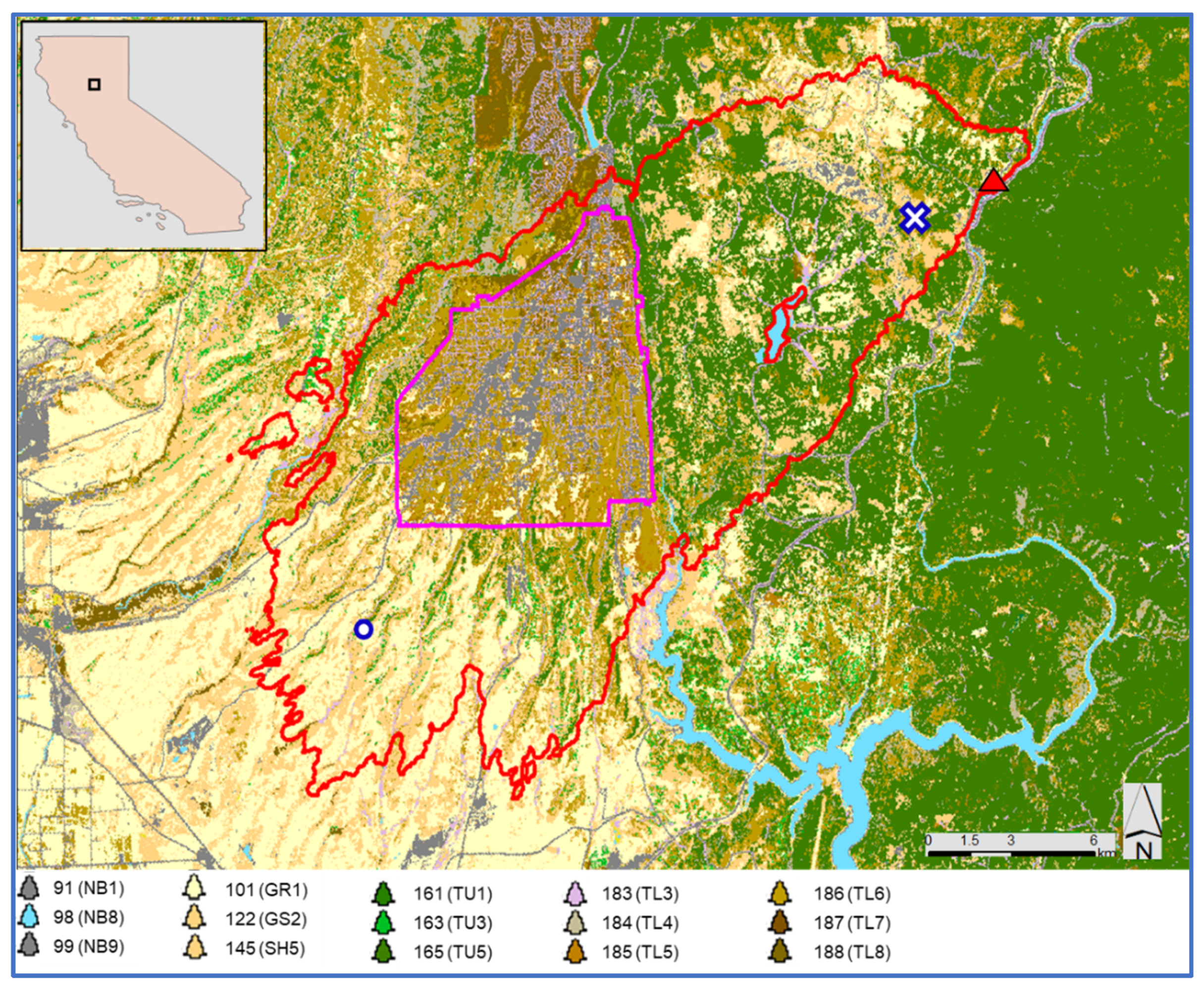

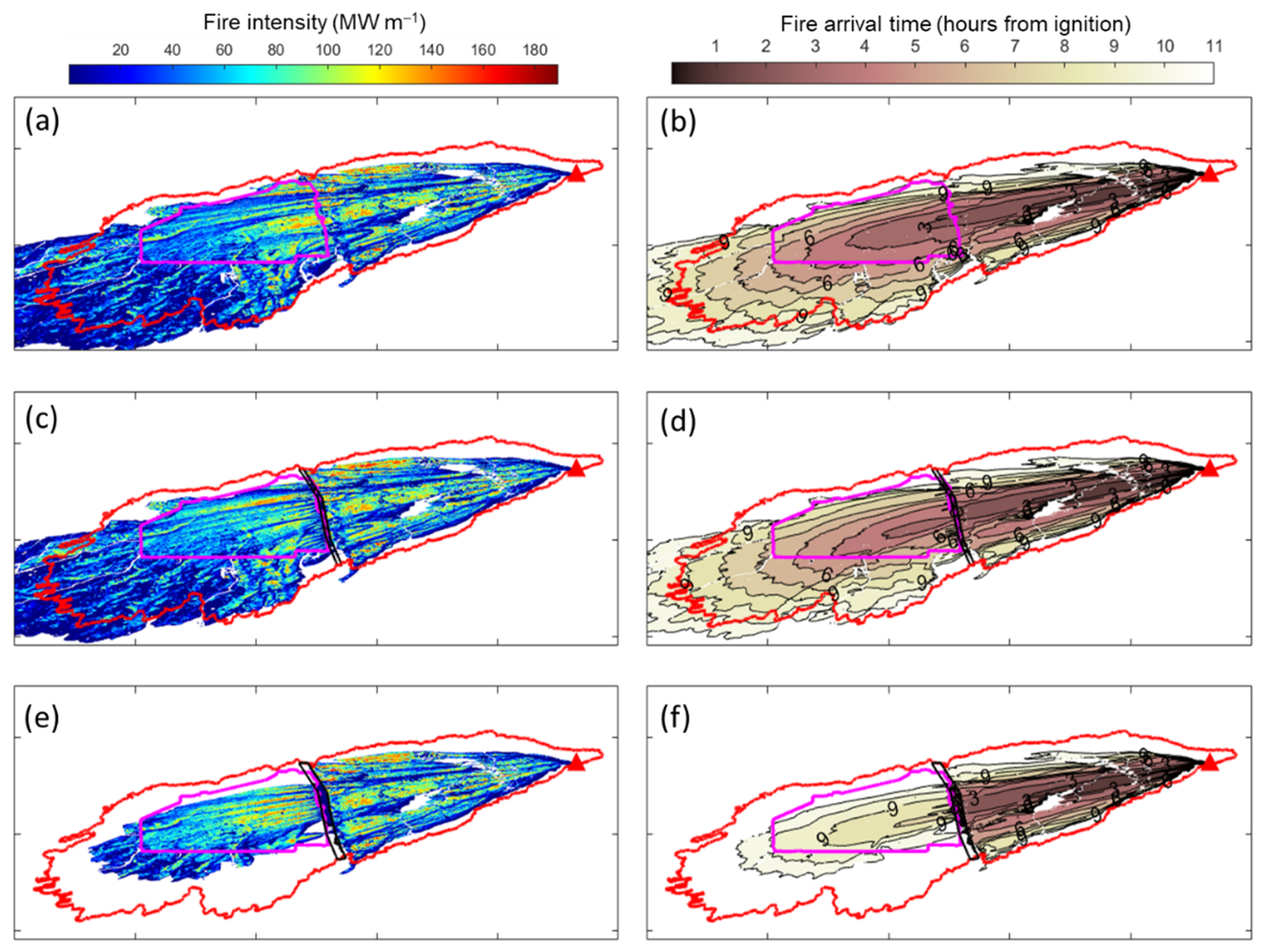
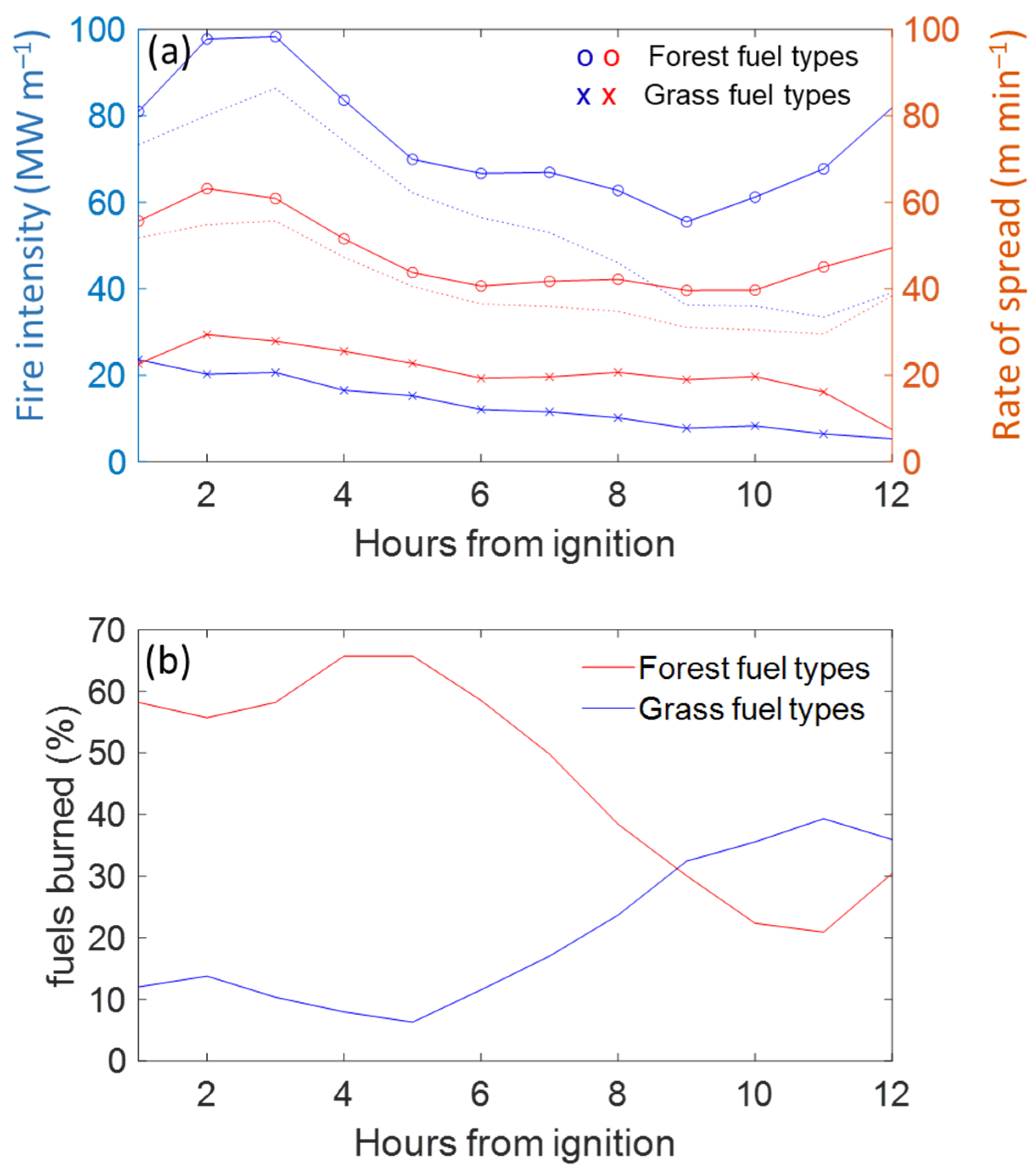
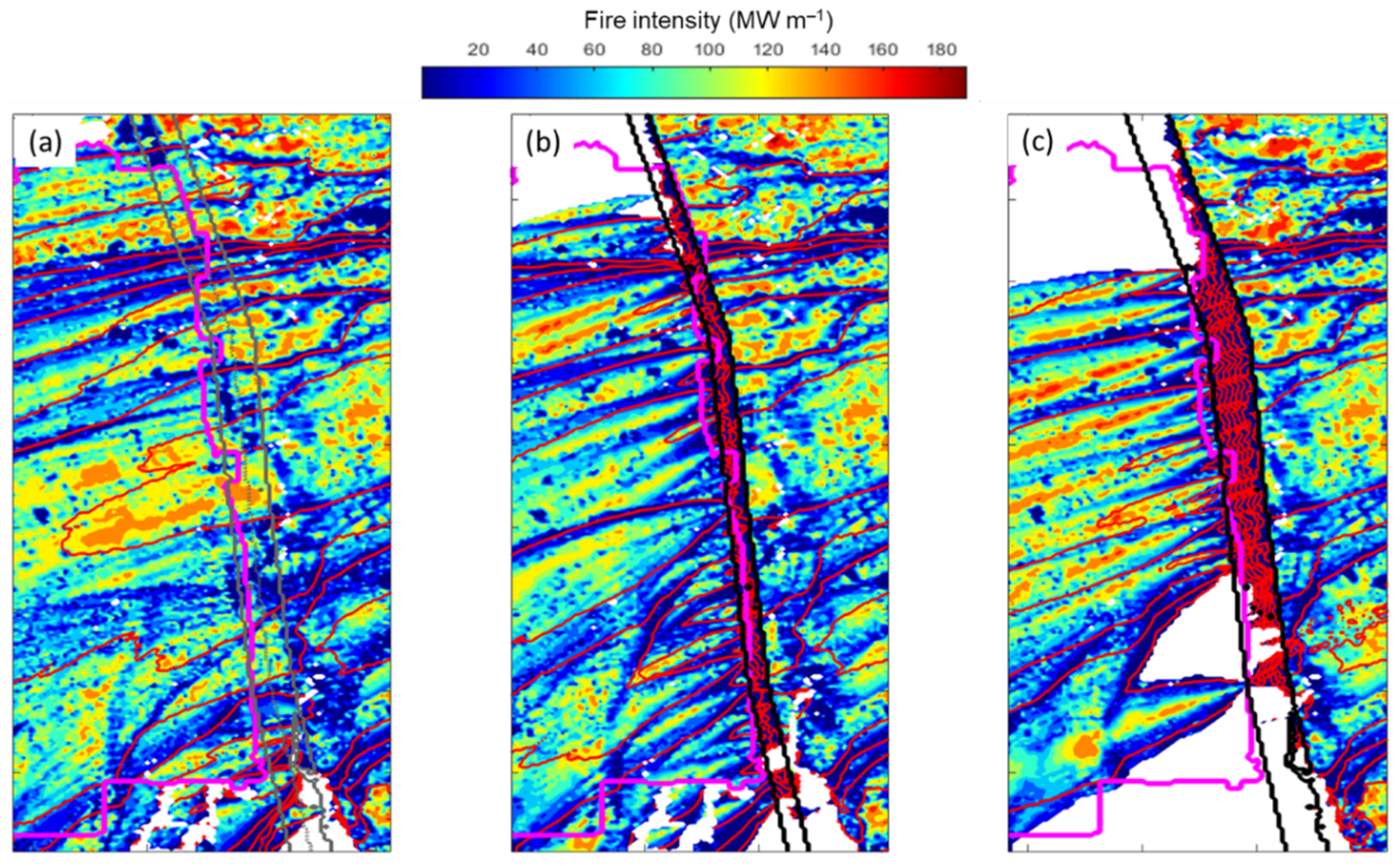
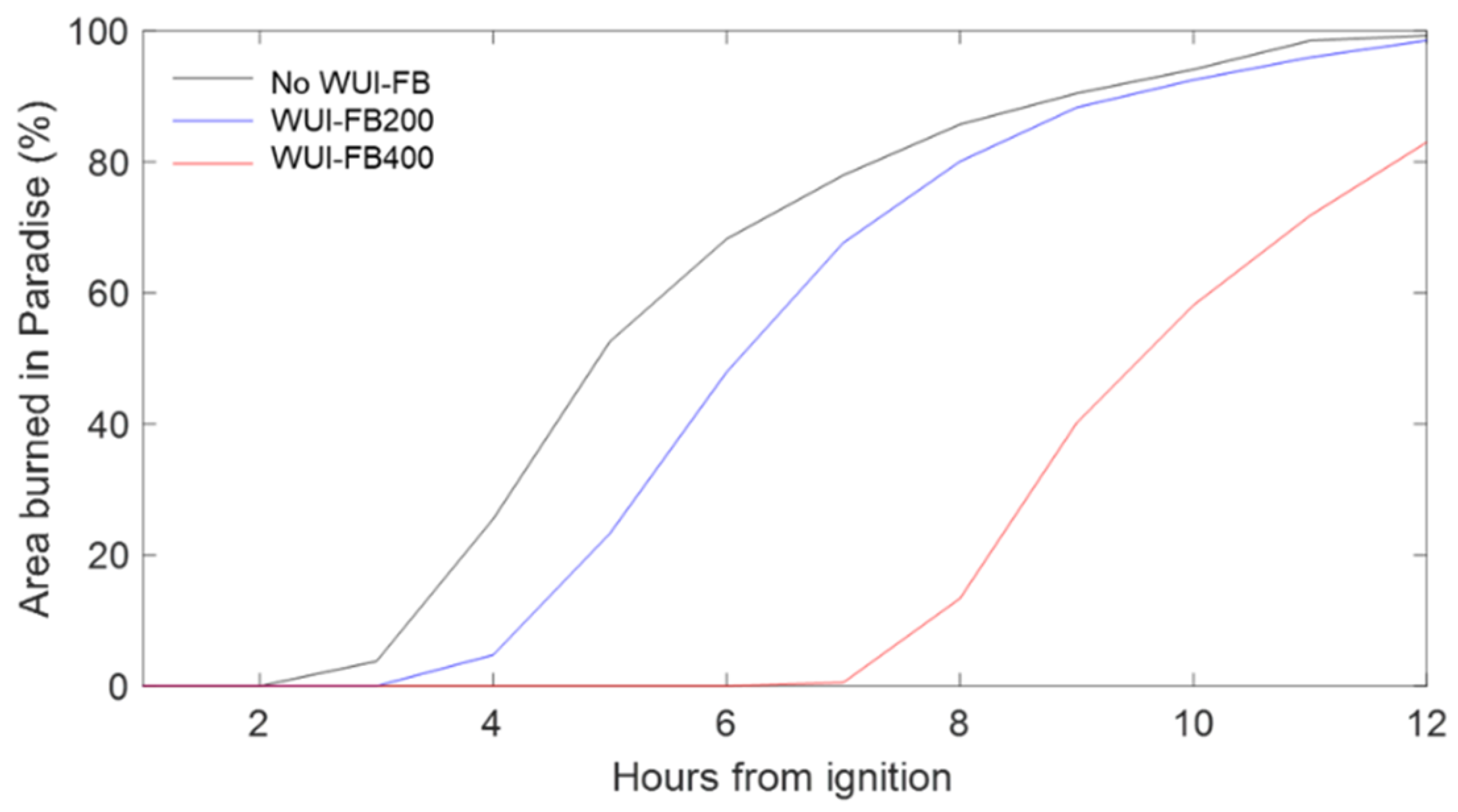
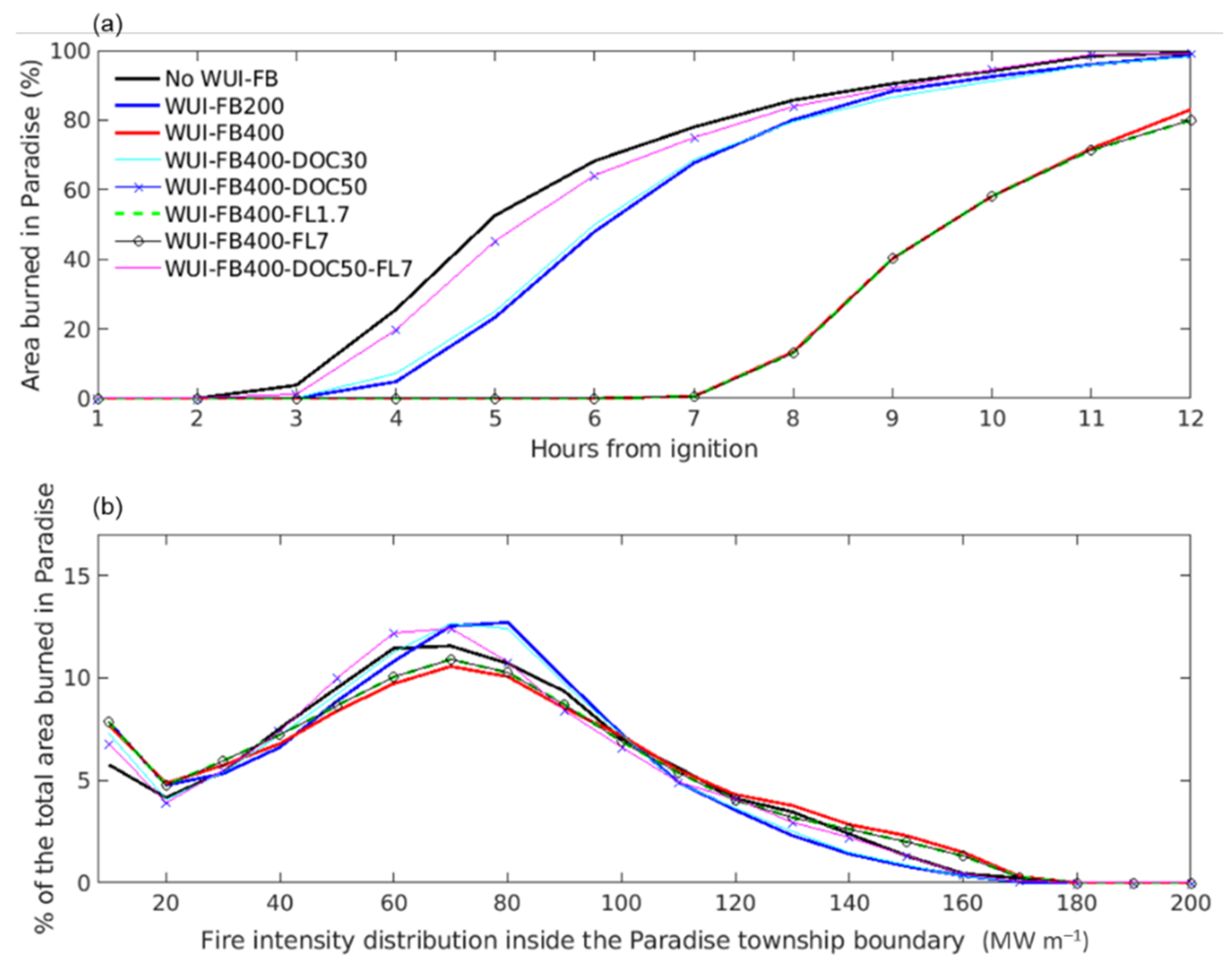
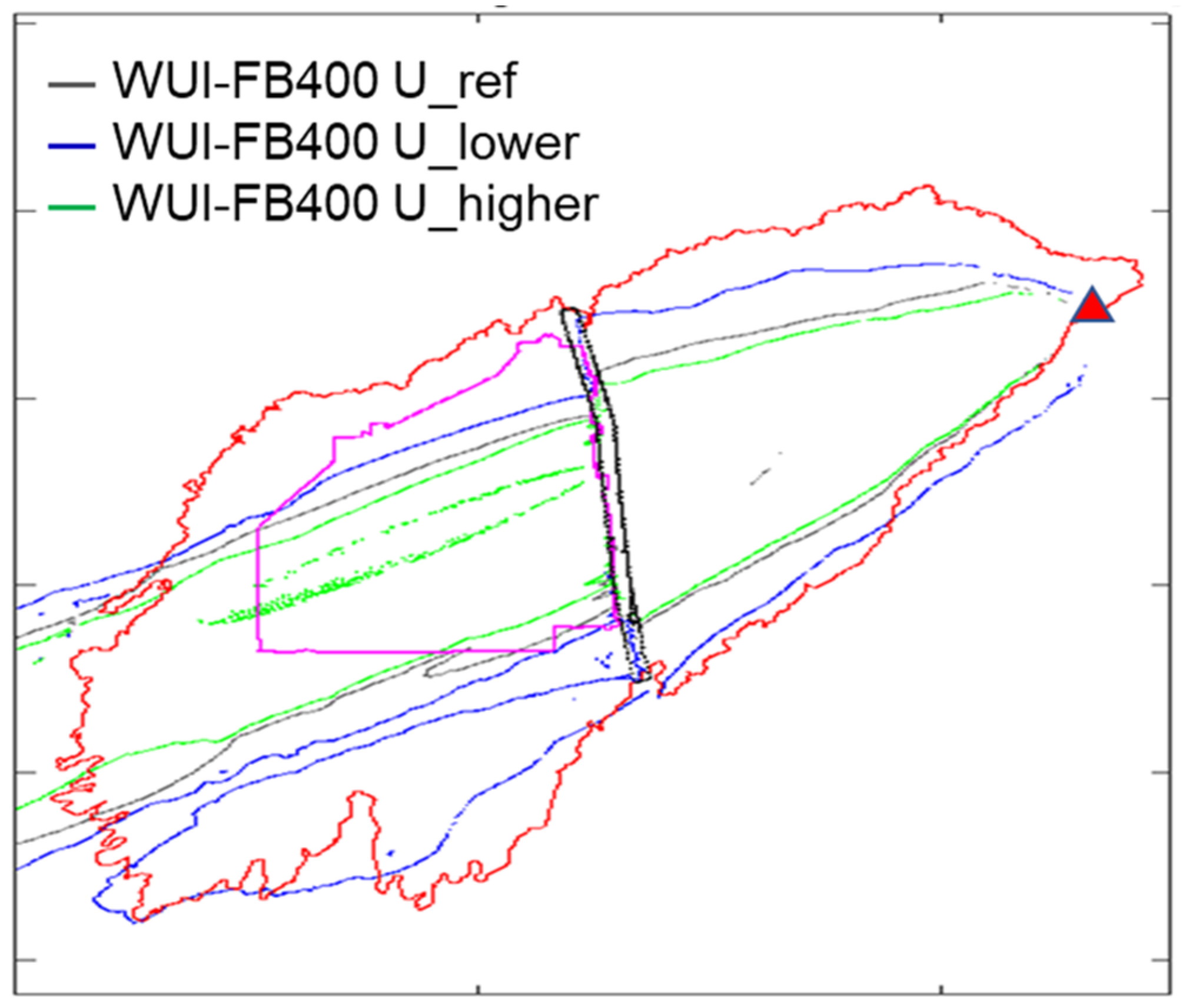
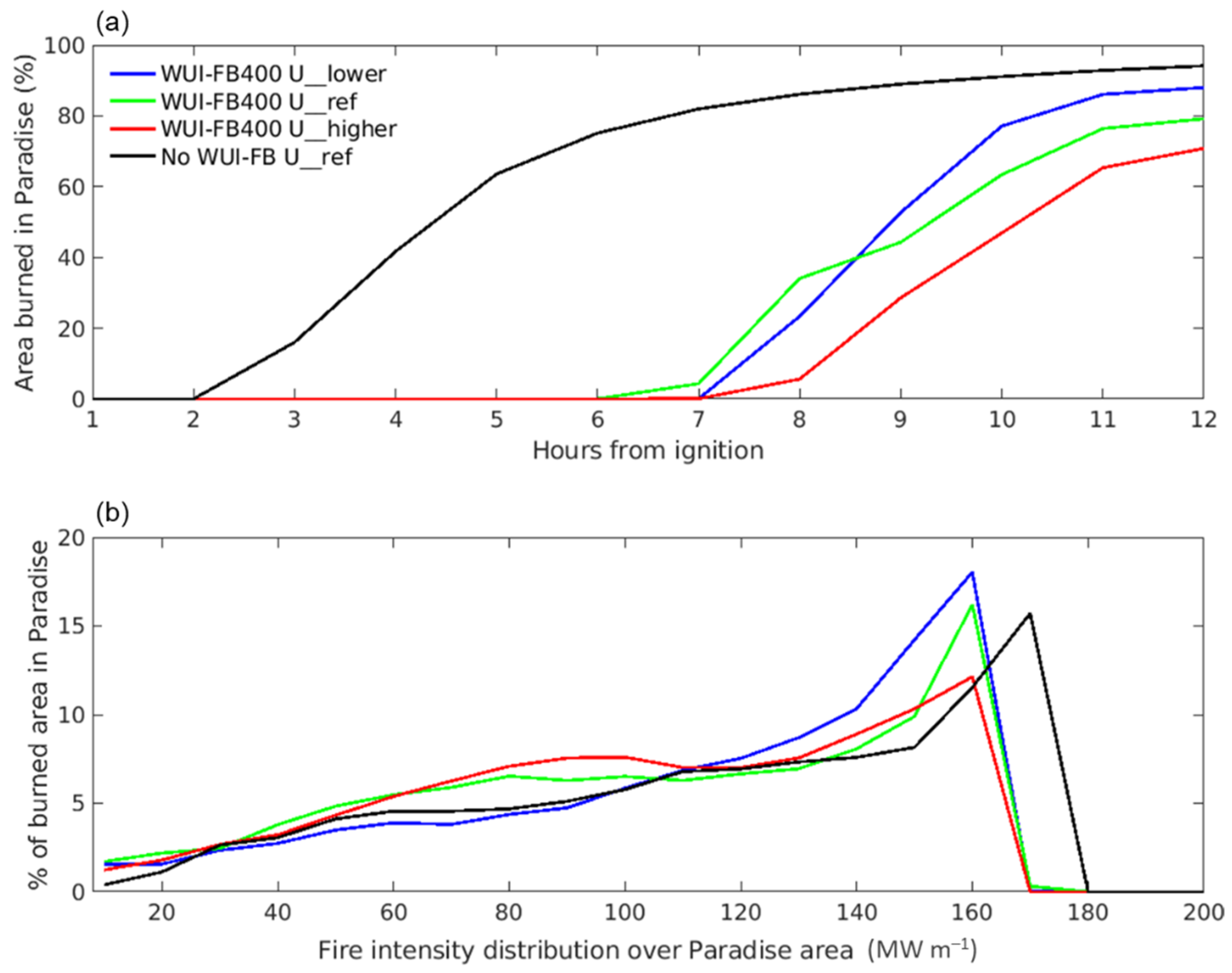
| Scott and Burgan (2005) Fuel Model | Brief Description | Fuel Type Assigned in Prometheus | Fuel Fractions Inside Observed Perimeter (%) |
|---|---|---|---|
| 165 (TU5) | Timber-Understory. Heavy forest litter with shrub. | M-1 (90% percent conifer). | 42.6 |
| 186 (TL6) | Timber Litter. Moderate fuel load. | M-1 (90% percent conifer). | 14.0 |
| 188 (TL8) | Timber Litter. Moderate fuel load. | M-1 (90% percent conifer). | 7.1 |
| 102 (GR2) | Low load grass. | O-1b (3.5 t ha−1 fuel load, 60% cured). | 7.0 |
| 122 (GS2) | Grass-Shrub mixture. High spread rate. | M-1 (70% percent conifer). | 6.4 |
| 91 (NB1) | Non-burnable. Urban/suburban. | Replaced by TU5. | 6.1 |
| Simulation Name | Weather | Fuel | WUI Fuel Break | Scenario Description |
|---|---|---|---|---|
| No WUI-FB | hourly | spatially varying | No | verification run |
| WUI-FB200 | hourly | spatially varying | YES (200 m) | added a 200-m wide WUI fuel break. |
| WUI-FB400 | hourly | spatially varying | YES (400 m) | added a 400-m wide WUI fuel break. |
| WUI-FB400-DOC30 | hourly | spatially varying | YES (400 m) | same as WUI-FB400 except degree of curing of grass fuel break = 30% |
| WUI-FB400-DOC50 | hourly | spatially varying | YES (400 m) | same as WUI-FB400 except degree of curing of grass fuel break = 50% |
| WUI-FB400-FL1.7 | hourly | spatially varying | YES (400 m) | same as WUI-FB400 except fuel load of grass fuel break halved |
| WUI-FB400-FL7 | hourly | spatially varying | YES (400 m) | same as WUI-FB400 except fuel load of grass fuel break doubled |
| WUI-FB400-DOC50-FL7 | hourly | spatially varying | YES (400 m) | same as WUI-FB400-DOC50 but fuel load of grass fuel break also increased by 50% |
| No WUI-FB U_ref | constant | uniform | No | reference run with a constant input weather stream over time |
| WUI-FB400 U_ref | constant | uniform | YES (400 m) | Same as above but with a 400 m WUI fuel break |
| WUI-FB400 U_lower | constant | uniform | YES (400 m) | with a 400 m WUI fuel break and 25% lower wind speed than reference run |
| WUI-FB400 U_higher | constant | uniform | YES (400 m) | with a 400 m WUI fuel break and 25% higher wind speed than reference run |
| Temp (°C) | RH (%) | WS (m s−1) | WD (°) | Fuel Type |
|---|---|---|---|---|
| 6.3 | 28 | 20, 26, 32 | 64 | M-1 (90pc) |
Publisher’s Note: MDPI stays neutral with regard to jurisdictional claims in published maps and institutional affiliations. |
© 2022 by the authors. Licensee MDPI, Basel, Switzerland. This article is an open access article distributed under the terms and conditions of the Creative Commons Attribution (CC BY) license (https://creativecommons.org/licenses/by/4.0/).
Share and Cite
Seto, D.; Jones, C.; Trugman, A.T.; Varga, K.; Plantinga, A.J.; Carvalho, L.M.V.; Thompson, C.; Gellman, J.; Daum, K. Simulating Potential Impacts of Fuel Treatments on Fire Behavior and Evacuation Time of the 2018 Camp Fire in Northern California. Fire 2022, 5, 37. https://doi.org/10.3390/fire5020037
Seto D, Jones C, Trugman AT, Varga K, Plantinga AJ, Carvalho LMV, Thompson C, Gellman J, Daum K. Simulating Potential Impacts of Fuel Treatments on Fire Behavior and Evacuation Time of the 2018 Camp Fire in Northern California. Fire. 2022; 5(2):37. https://doi.org/10.3390/fire5020037
Chicago/Turabian StyleSeto, Daisuke, Charles Jones, Anna T. Trugman, Kevin Varga, Andrew J. Plantinga, Leila M. V. Carvalho, Callum Thompson, Jacob Gellman, and Kristofer Daum. 2022. "Simulating Potential Impacts of Fuel Treatments on Fire Behavior and Evacuation Time of the 2018 Camp Fire in Northern California" Fire 5, no. 2: 37. https://doi.org/10.3390/fire5020037
APA StyleSeto, D., Jones, C., Trugman, A. T., Varga, K., Plantinga, A. J., Carvalho, L. M. V., Thompson, C., Gellman, J., & Daum, K. (2022). Simulating Potential Impacts of Fuel Treatments on Fire Behavior and Evacuation Time of the 2018 Camp Fire in Northern California. Fire, 5(2), 37. https://doi.org/10.3390/fire5020037







